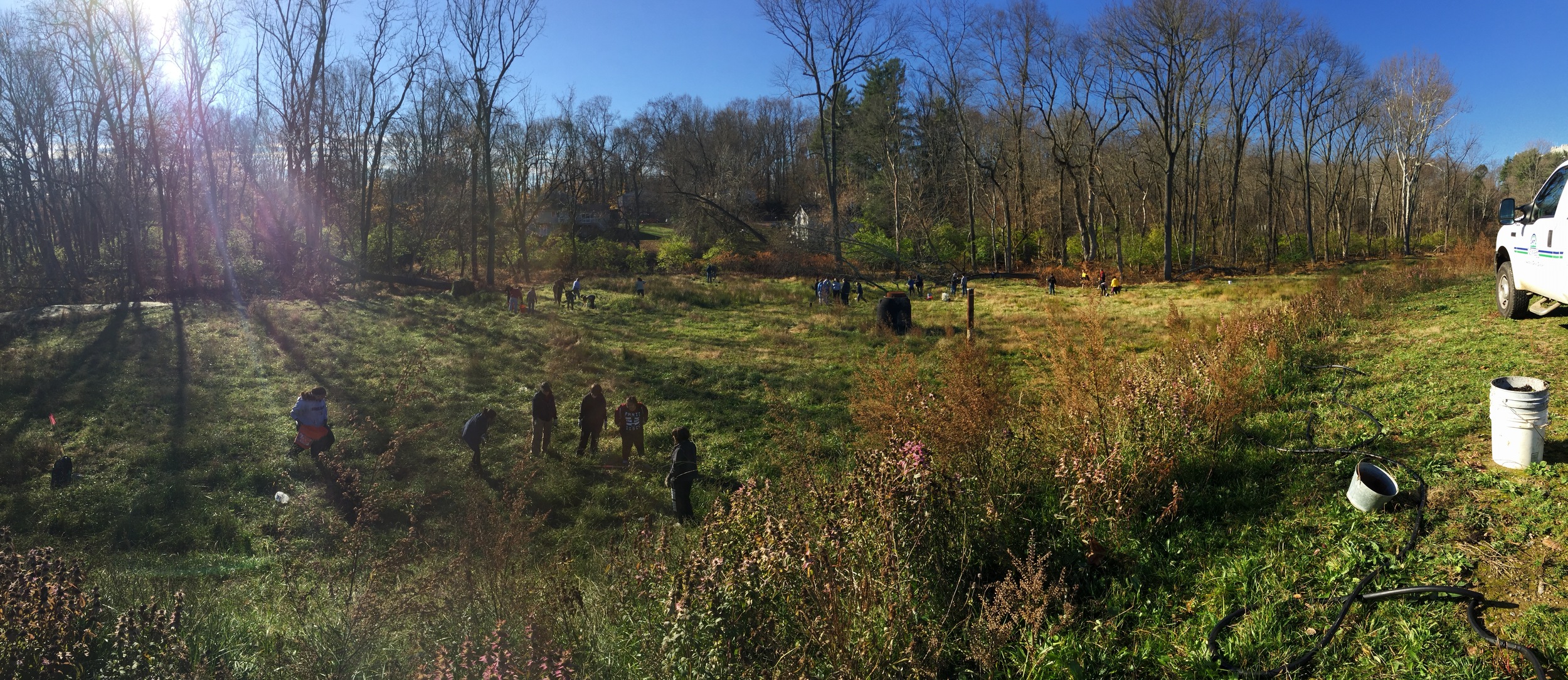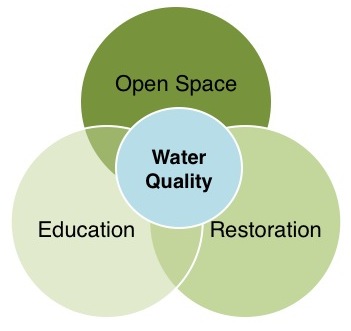Students from Newark High School planting trees and shrubs along the White Clay Creek.
On a blustery Saturday morning, November 21, the White Clay Creek Wild and Scenic Rivers Program sponsored a habitat planting at Curtis Mill Park in Newark, DE. Thirty local volunteers, including students from Newark High School’s Nature Society and AP Environmental Science course, assisted in planting 100 native trees and shrubs along the banks of the main stem of White Clay.
An increased presence of native plants in the buffer zone and floodplain provide numerous valuable services to the natural environment. Some of these services include the creation of habitat, shelter, and food for wildlife. The plants are also vital to stream health because they capture, infiltrate, and treat polluted runoff from adjacent Papermill Road. The planting area, which is part of the public park, will also contribute benefits to park visitors of all ages through improved aesthetics of the streamside landscape.
Planting additional layers of vegetation (shrubs and understory trees) where the wet meadow meets the exiting tree line provides additional habitat diversity for a variety of wildlife. As it matures it will also buffer the forest edge from the invasion of aggressive non-native species such as Morrow's honeysuckle, and multi-flora rose.
Bob McDowell, a teacher at Newark High School and a handful of his students played an integral role in the success of the planting. Mr. McDowell is the instructor of the school’s Advanced Placement Environmental Science course and was pleased to have more than 20 of his students participating in the event. Bob indicated that many of the topics that he covers in his classes had practical applications to the planting. Riparian buffers, floodplains, and conservation techniques are just a few of the concepts he hoped were conveyed to his students.
“Through this hands-on experience, I hope the students gain an appreciation of the natural ecology of Newark. I hope that years down the road, some of these students can return to the park and remember how they influenced their community landscape in a positive way.”
During the planting, some students were able to observe the influence of the centuries-long historic industrial land-use of the site, which was formerly occupied by the Curtis Paper Mill. While digging, some uncovered old metal scraps, remnants of the past use of this site. Other site constraints related to it’s location in an urbanized part of the White Clay, include a sewer main that bisects the floodplain. The mature size of the plantings and their locations, had to be carefully selected and placed to not interfere with the sewer easement. A wetland meadow of low growing native plants was seeded in the floodplain after construction and is evidenced by the dark green rushes and yellow-green sedges. These ground cover plants will provide food and cover in areas where larger species needed to be avoided.
Bob McDowell is also a member of the City of Newark Conservation Advisory Committee. Through his partnership with the City of Newark, he hopes to foster future community conservation projects with his students on city property that would similarly benefit from stream cleanups, or habitat plantings.His group is planning to return to Curtis Mill Park in the spring to carry out additional reforestation with native plant species.
“These types of partnerships are exactly what we like to encourage between today’s youth, municipalities, and conservation groups. They provide our future leaders with the knowledge and the tools to solve real world problems - and give them the opportunity to be a part of the solution. Conservation landscaping is just one of those tools that not only benefits wildlife and water quality, but also the community as a whole.”
Funding for this project came out of the White Clay Creek Wild and Scenic River Restoration Fund set up for Delaware taxpayers who claim an over payment of taxes, or who have an income tax liability, to designate an amount to be deposited or paid to the Fund. Over the past four years, this Fund has raised just under $25,000 for water resource restoration and management programs within the White Clay Creek watershed, Delaware’s only federally designated wild and scenic river. More specifically, these funds have and will continue to support projects such as dam removals (for fish passage), freshwater mussel restoration and research, and conservation landscaping.
Click to view additional photos from the planting.























